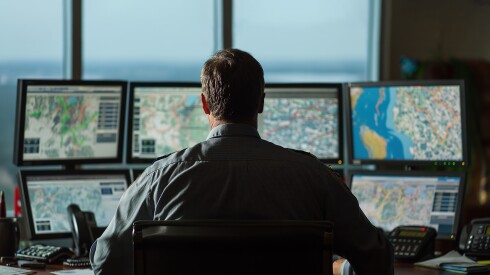-
A new suite of technology will enable real-time text updates to 911 callers on response times and delays. It will also let callers critique and review police officers, the city’s interim police chief said.
-
The company’s newest device for law enforcement combines body camera technology with a microphone that can record different vocal tracks. A company executive explains the appeal of the new AI-backed offering.
-
The question of where speed cameras are allowed and where they aren't reveals a deeply divided nation. Government Technology mapped state laws and the locations of hundreds of speed camera programs across the country.
More Stories
-
Meta CEO Mark Zuckerberg returned to Washington this week, testifying in a landmark trial that could force the world's largest social network to break off Instagram and WhatsApp.
-
Governments are increasingly using specialized anonymous digital tip lines to tackle niche community issues. The data, however, has become an attractive target for threat actors. Here's how one company is responding.
-
As of May 1, neither citizens nor media will be able to monitor 911 channels. The change comes amid a nationwide debate about how to protect the integrity of investigations while balancing the public's right to information.
-
Many U.S. school districts have turned to technology, especially digital surveillance, as the antidote to campus violence. Not everyone is sold on that approach, as it can raise issues with privacy and security.
-
State Police have spent more than $40 million during the last two years to buy 2,000 body cameras, software, and expanded-view cameras for 1,400 patrol vehicles. All personnel are now equipped, weeks ahead of time.
-
Based in Michigan, the data-sharing operation has about 250 agencies, with 2,000 members anticipated by 2030. One of the technology leaders behind this push details what’s coming next, and why.
-
A two-month pilot study of moving violations near school buses in Nevada's largest county found 6.1 violations each day per bus. Now the State Assembly is considering a bill to allow schools to use enforcement cameras.
-
Officials in Alabama's Morgan and Limestone counties report that a child playing with a parent's smartphone is the most common cause of an accidental call to 911. Apple Watches' fall detection feature is another culprit.
-
When residents of a ritzy West Los Angeles neighborhood experienced an increase in burglaries last year, they decided to invest in technology for the police department to fight the problem.
-
The city of around 25,000 will deploy 16 cameras to be used in open cases or other specific circumstances, such as finding suspects or missing children. A grant will fund about two-thirds of the devices.
-
Heat played a role in more than 500 deaths in Nevada last year. A legislative committee wants more information on when, where and how many residents are left without AC if they fail to pay when temperatures climb.
-
Public safety agencies are using drones to provide up-to-the-minute overhead coverage for officers on the ground. Police in Dunwoody, Ga., have used them to track suspects and find incident locations.
-
Legislation headed to the state Senate floor would let police statewide use drones to respond to 911 calls in progress, at crash scenes ahead of arriving officers and to chase fleeing suspects.
-
BRINC and SkySafe will work with the tech giant to provide better drone operations for first responders, reflecting a larger trend in government. BRINC also says it has raised $75 million in a new funding round.
-
An eight-month pilot program resulted in law enforcement recovering about 170 cars and arresting nearly 300 people, and it helped solve homicides, robberies and hit-and-runs, according to police.
-
Robots offer potential for public safety, but state governments — working with a big name in robotics — are grappling with how to regulate them, especially as the prospect of weaponization raises urgent concerns.
-
Drones are quickly taking on more roles in law enforcement, disaster management and other tasks. Their latest role is arriving at emergency situations before humans do, collecting information for police.
-
Moving to Next-Gen 911 is more than just a technical challenge; it's a moral imperative as public safety agencies work to meet the needs of all Americans, including those with disabilities or language barriers, during emergencies.
Most Read
- Fort Lauderdale Picks Exec for Acting CIO as McKay Departs
- New ISTE+ASCD Program to Pull Harmful Posts From Instagram, Pinterest
- Interim in Place, Portland, Ore., Mounts Search for Next CIO
- Philadelphia’s New Tools Illustrate Expansion of Free Wi-Fi
- Women Still Underrepresented in STEM Despite Job Demand



























